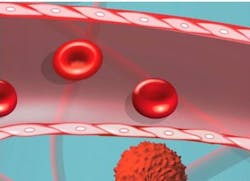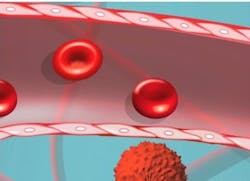Light-sheet microscopy method shows how stem cells exit the bloodstream
By using a light-sheet microscopy method, researchers at North Carolina State University (NC State; Raleigh, NC) discovered that therapeutic stem cells exit the bloodstream in a different manner than previously understood. This process, dubbed angiopellosis by the researchers, has implications for improving our understanding of not only intravenous stem cell therapies, but also metastatic cancers.
Related: Portable microscope images the flow of individual blood cells noninvasively
When white blood cells need to get to the site of an infection, they can exit the bloodstream via a process called diapedesis. In this process, the white blood cell changes its shape to squeeze between or through the epithelial cells that form the walls of the blood vessel. Diapedesis is a well-understood process, and researchers believed that other types of cells, like therapeutic stem cells or even metastatic cancer cells, exited blood vessels in a similar way—with the cells pushing or squeezing themselves out.
But a group of researchers led by Ke Cheng, associate professor of molecular biomedical sciences at NC State with a joint appointment in the NC State/UNC-Chapel Hill Department of Biomedical Engineering, found that these stem cells behaved differently.
Therapeutic stem cells share the same ability to exit the bloodstream and target particular tissues that white blood cells do. But the precise way that they did so was not well understood, so Cheng and his team utilized a zebrafish model to study the process. The genetically modified zebrafish embryos were transparent and had fluorescently marked green blood vessels. Researchers injected the embryos with white blood cells and cardiac stem cells from humans, rats, and dogs. These cells had all been marked with a red fluorescent protein.
Through time-lapse 3D light-sheet microscopy, Cheng and his team could trace the progress of these cells as they left the blood vessel. The white blood cells exited via diapedesis, as expected. When stem cells exited the blood vessel, however, the endothelial cells lining the vessel actively expelled them. Membranes surrounding the endothelial cells on either side of the stem cell stretched themselves around the stem cell, then met in the middle to push the stem cell out of the vessel.
"When you're talking about diapedesis, the white blood cell is active because it changes its shape in order to exit. The endothelial cells in the blood vessel are passive," Cheng says. "But when we looked at therapeutic stem cells, we found the opposite was true—the stem cells were passive, and the endothelial cells not only changed their shape in order to surround the stem cell, they actually pushed the stem cells out of the blood vessel. We've named this process angiopellosis, and it represents an alternative way for cells to leave blood vessels."
The researchers found two other key differences between angiopellosis and diapedesis: angiopellosis takes hours rather than minutes to occur, and angiopellosis allows more than one cell to exit at a time.
"Angiopellosis is really a group ticket for cells to get out of blood vessels," Cheng says. "We observed clusters of cells passing through in this way. Obviously, this leads us to questions about whether other types of cells, like metastatic cancer cells, may be using this more effective way to exit the bloodstream, and what we may need to do to stop them."
Full details of the work appear in the journal Stem Cells; for more information, please visit http://dx.doi.org/10.1002/stem.2451.

